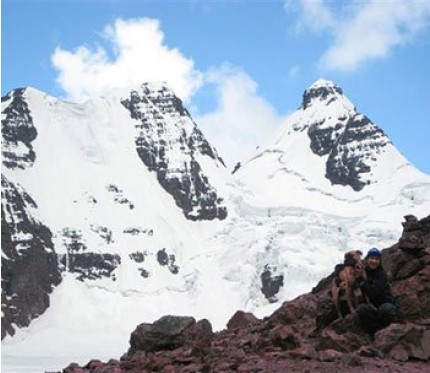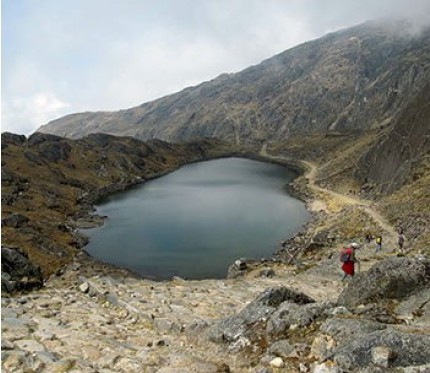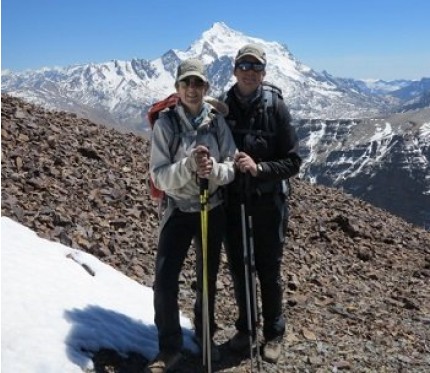MOUNTAIN CLIMBING & TREKKING BOLIVIA
Bolivia has a wide range of climbing and trekking opportunities for both novice and expert a like.
For some reason though Bolivia doesnt see the high numbers of trekkers and climbers like Peru and because of this there are less opportunites to join up with set departure groups.
Only a handful of treks and climbs have regular groups departing so if you are looking for something more specialist it is much easier if you are doing so as a group.
If this is the case contact us with your requirements and we will try to put together a proposal for you.
Here we will provide information on the most popular Treks and Climbs aswell as some useful information to help you plan your trip in advance.
About Climbing & Trekking in Bolivia
Bolivia has a very diverse range of environments from the steamy Amazon jungle to the Andes mountain range.
Obviously much of the trekking and all of the climbing takes place in the mountainous areas and this makes La Paz the ideal base for most of the trekking & climbing trips.
The Cordillera Real mountain range can be reached from La Paz in just a couple of hours drive making a number of treks and climbs very accessible from the city.
Additionally the fact that La Paz is at an altitude of 3600 meters also makes it ideal for acclimitization purposes - an important factor we will discuss more below.
Trekking Tours
Takesi Trek
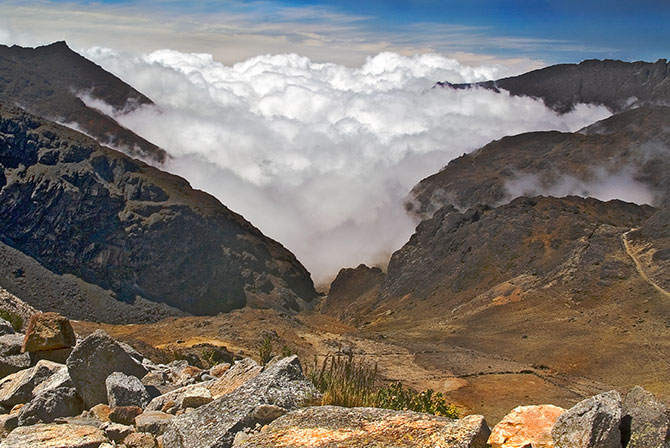
Whilst there are many possabilities for trekking in Bolivia there are a number of routes that are considered the classic trails
Some of these are ancient Inca Trails that wind down from the mountains through to the semi tropical Yunagas areas.
There are also treks in the mountains that range from easy 1 day options through to epic 15 day traverses of the Cordillera Real mountain range.
Here is our pick of the top treks:
- El Choro Trek - the most popular trek due to its easy access from La Paz starting at La Cumbre about 1 to 1.5 hours drive from the city center. This 3 day trek starts at an altitude of about 4600 meters and follows inca roads winding down through mountains, descending into cloud forest and semi tropical forests. Wonder views of the Yungas valleys, rivers, local villages and rural life this trek is of average difficulty and involves lots of small ascents and descents. As an added bonus the trek finishes near the popular town of Coroico and most choose to stay for a day two to rest after finishing the trek.
See full details for the 3 Day El Choro Trek - Takesi Trek - this trek can be done as a 2 day or 3 day option with the latter recommended in order to allow more time to enjoy the trek and not feel rushed. It starts with a steep climb of around 1 to 1.5 hours or so from the village of Ventilla and when we reach the top you can look down on the winding Inca Trail. This first section is where you find some of the best preserved stone Inca Paving which you will follow past a lake down towards the Takesi village. The village itself hasnt changed for centuries.Most of the trek is downhill and very picturesque. The trek finishes near the ugly mining town of Chollija but you can continue to the much more appealing Yanacachi.
See full details for the Takesi Trek - Tuni Condoriri & Pico Austria - this 1 day trek offers stunning mountain scenery starting about 2 to 2.5 hours from La Paz. Although high altitude the approach trail is gentle and the standard trek is not too challanging. Those that choose the option of Pico Austria will hike up a steep trail to a 5300 meter pass that gives great views of the mountains around and the valley and lakes below.
See full details of Tuni Condoriri Pico Austria 1 Day Trek - Laguna Glacial Sorata - starting in the village of Sorata this trek takes you up to the base of Illampu and Janko Uma mountains wereby lies a beautifully pristine glacial lake. The trek is usually done in 3 days with day 1 walking up to camp at Laguna Chillata, day 2 up to the Laguna Glacial and back with day 3 used for an easy descent back to the town. The area has had some problems with robbery of trekkers and belongings so it is normal to hire a guardian to sit with the equipment at the lake whilst you trek on day 3. We do not offer this trek any more due to such issues in the area but it is possible to arrange directly with the guides association just of the main plaza in Sorata.
- Cordillera Real Traverse - there are a few variations of thise trek but the classic route goes from Sorata to zongo valley covering some 120km and taking about 14 to 15 days. This is the most epic of all the treks in Bolivia and will take you to areas seldom seen by tourists. The first section near Sorata has experience issues over the years from robberies so you would need to check out the latest info in sorata about this and be aware. For this reason we do not currently offer this but hope to in the future as it is one of teh top treks in the world.
- Yunga Cruz Trek - this is the 3rd of the classic Inca Trails of Bolivia but by far the less walked. During this 5 day (also possible longer with variations) it is not uncommon to not see a single other person as you trek along remote mountain passes, through over grown forests (a machete is advisible for this trek , especially just after rainy season) and down towards the town of Chulumani in the South Yungas.
We can arrange this trek for groups upon request and subject to available guides. - Apolobamba Trek - is in a remote area in northern Bolivia towards the border with Peru. The trek can be done in both directions from Curva to Pelechuco or reverse. The area of curva is known as the home of the Kallawayas , famous traditional healers of Bolivia that have a their own secret language passed on through the generations. The trek is usually done over 5 days (plus travel time to the area and back adding 2 more days) and mostly in high altitudes over 4000 meters. The area is sparsely populated but there are some small villages. Transport to the area is very limited with buses to/from Pelechuco and Curva just a few times per week from La Paz. We do not offer this tour in general but for larger groups (or 5 or more) could arrange upon requests subject to availability.
Climbing Tours
Huayna Potosi 6088 meters
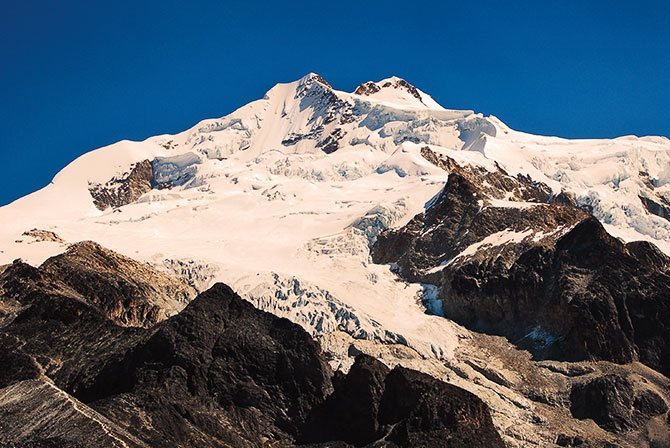
For climbers wanting to add some 6000 meter peaks to their list of summits Bolivia offers suitable options for all abilities
There are also more than 600 mountains over 5000 meters in the country many of which are seldom climbed.
Here is our pick of the top climbs:
- Huayna Potosi - the most popular mountain to climb in Bolivia for many reasons but primarily because it can be attempted by complete beginners with no previous mountaineering experience making it the best opportunity for many people to try the sport for an exceptionally low cost compared to arranged tours in Europe and the USA. Additionally, there are very few places in the world where people can climb a 6000 meter mountain at such a low cost and with no experience.We have regular departures for this climb and in fact if you have 2 or more people we can usually confirm a tour for any date you pick. It is possible to climb year round although during times of high snow / wind for safety reasons it is not possible.
See full details for 3 Day Huayna Potosi Climb - Sajama - is the highest mountain in Bolivia standing at 6549 meters and stands alone on a windswept plain. It is only possible from May through to around October as outside of this time the high winds and conditions make it two dangerous. Even though it is the highest mountain in the country it is not technically difficult so it is popular to climb as a second mountain after summiting Huayna Potosi. The altitude though of course makes it a challange so good acclimitization is essential.
See full details for 4 Day Sajama Climb - Pequeno Alpamayo - standing at 5370 meters this mountain is not high by local standards but it is considered amongst the most beautiful with its perfect conical peak. It can be attempted by confident beginners as it is not very technical but some basic prior experience would be desirable as it involves some steeper climbing that Huayna Potosi along a very exposed ridge.
See full details for 3 Day Pequeno Alpamayo Climb - Illimani - this iconic mountain is known as the guardian of La Paz and can be seen towering in the distance from many parts of the city. It is the second highest mountain in Bolivia at 6438 meters and climbers attempting this climb should have some experience. Whilst not extremely technical some sections can be icey with lots of cravasses and the mountain has caused more fatalities than any other in Bolivia , although this is in part due to the harder more technical routes that some have failed on. It is only possible during the dry season from May through to October and usually takes 4 days from La Paz.
See full details for 4 Day Illimani Climb
Acclimatization & Fitness
Tuni Condoriri Pico Austria
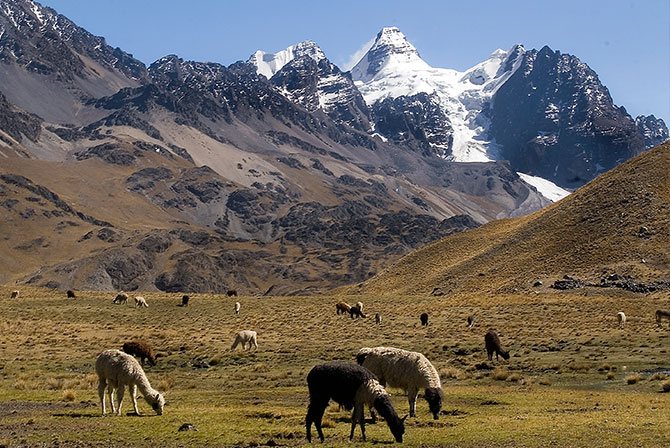
Some of the shorter treks dont require particially high levels of fitness but in general all multi day treks and climbs require at least a moderate level of fitness.
What is 'moderate' ? - a basic interpretation is that you should be able to walk , carrying a backpack, for at least 7 hours per day with a few breaks and a lunch stop.
This is average time for trekking days on many treks but you should check the itinerary to be aware as sometimes days can be longer or shorter, involve lots of steep climbs or decents , which can effect energy required.
For climbing you should aim for a higher level of fitness as it is a more strenuous activity than trekking and it is best if you can do some training before hand if possible.
For climbing the best training is climbing mountains! But we understand thats not always possible so a mixed plan of trekking/hiking whenever possible with weekly cardio (running & biking), strength training for legs (squats, dumbbell lunges, presses are good) and strenghening of back and core are all recommended.
The level you train to will entirely depend on your current fitness, age and what you actually plan to climb. Some climbs are commonly climbed by people with no focused training and general fitness levels.
Of course the altitude of a trek or climb makes a big difference also. The higher the altitude the more stress is placed on your body and this increases exponially the higher you go.
Acclimitization is something that is often not taken seriously enough by many people but it can absolutely be the difference between summiting a mountain or not. It can mean a trek feels much harder for someone than for their more acclimitized colleagues.
In general for climbing we recommend you spend at least 5 days constantly at an altitude of over 3000 meters prior to attempting climbs such as Huayna Potosi , but really you should aim for 7 days or more.
With some itinararies this can be happen quite easily. For example if you spend some time in Cusco, do a trek for a few days, travel from Cusco to Puno , Copacabana then onto La Paz then all of those places are above 3000 meters and will mean your body is quite well adjusted.
Another example is for people coming from the south of Bolivia or from San Pedro de Atacama in Chile and taking one of the 3 Day Salt Flats Tours , which spend most of the time above 4000 meters and even travel as high as 5000 meters over some passes.
Something to note though , and a mistake some people make, is that you have to make sure you don't go to lower altitudes during this acclimitization period as you will start to declimitize as your blood cell count readjusts back to its previous levels.
For example we have seen well acclimatized people arrive in La Paz, then take a trip down to the Pampas & Jungle in Rurrenabaque, which is around 300 meters, then return wanting to climb a mountain but find they are struggling to be at the altitude of La Paz.
Equipment Advice
Typical Examples of Climbing Equipment Supplied on Tours
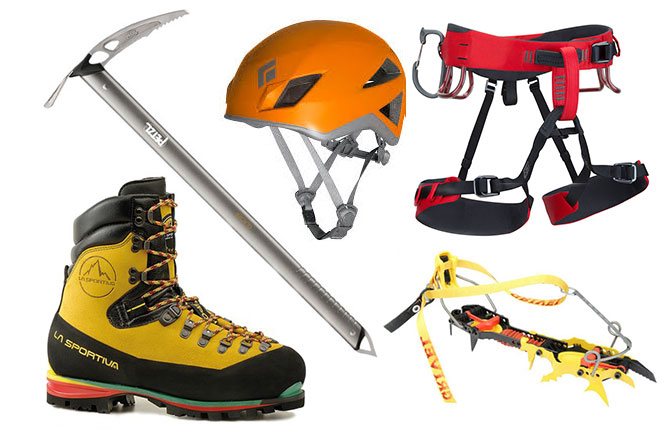
Equipment For Mountain Climbing
Climbing tours in Bolivia will usually include specialist equipment such as mountaineering boots, crampons, harness, ice axe,ropes, helmet, gaitors plus some of the clothing such as mountain jacket, gloves, insulated trousers.Headtorches are often included but you need to supply your own batteries
You will usually need to bring your own backpack, trekking boots for approach hikes, inner clothing layers such base layer, mid layer, insulation layer. liner gloves to go inside mountain gloves, trekking/climbing socks, fleece hat and sunglasses.
Sleeping bags are not usually included but can be hired and it is often possible to lend an item if you are missing something , like a fleece or backpack for example but you would need to check as it is not on the included list
- Climbing Boots & Crampons - for most climbs in Bolivia you will be needing B3 boots and C3 crampons. These boots are have rigid soles allowing the best control of crampon points for technical climbing and are usually highly insulated with thick soles, inner insulted liner boots covered by a highly water proof outer boot. They can be quite heavy and not well suited to apprach walks on rocky trails so it is best to use trekking boots until the snowline. For some of the lower peaks you might get away with B2/C2 especially during the warmer times of the year.
Most climbing agencies supply boots with their climbing tours (varying greatly in condition and quality) and often use model like La Sportiva Nepal Evo (or older versions) or similar from other brands such as Scarpa Vega. Always make sure you try on the boots before leaving for the mountains and also check the crampons fit on the boot well and are not likely to cause problems slipping off. If you are partaking in a climb with icey sections then it is best to have crampons with sharp points that are not too worn. - Ice Axe - For most climbs a classic mountaineering axe is sufficient and sport ice climbing axes are not required.
- Harness - you will be wearing your harness the entire time on the snow and the rope will be attached, via a karabina. Most harnesses last a long time but you should ensure that the tie in loop at the front is not too warn.
- Helmet - climbing helmets are essential equipment to protect from falling rocks, equipment etc
- Trekking Poles - are optional and are usually not included but might be availalbe upon request
Equipment For Trekking
Trekking tours will usually include tent, sleeping matttress, cooking & eating equipment (stove,fuel, pans, plates, bowls, cutlery etc) with sleeping bags available to rent at an additional cost. Guide often carry a basic first aid kit.
You would need to bring your own suitable clothing, water bottle, personal medicines, additional snacks, sun glasses, sun cream, insect repellents etc.
Of course some people choose to trek independently and if they dont bring everything with them look for equipment and supplies upon arrival in Bolivia.
In the past there wasnt much availability of camping equipment but now it is quite easy to buy things in La Paz although alot of things are not top quality and there are many fake items of top brands.
For example, North Face branded clothing is easy to find but is counterfit. The Chilean brand DOITE is good value, readily available and not fake. You can find original brands such as Black Diamond, Marmot and others in The Wall Adventure on Calle Illampu located next door to Kanoo Tours office but if you can bring things with you it will be cheaper as imported equipment is highly taxed and therefore expensive.
- Camping Stoves & Fuel - in the past years it was very difficult to find gas cannisters for stoves in Bolivia but lukcily now it is easy to find both stoves and cannisters for sale from the multitude of camping gear shops on Calle Illampu in La Paz. Something that is difficult to come by though is white gas of the kind commonly used in MSR type stoves. If you ask around you might find it but it certainly varies in quality , with some burning very dirtily . Make sure to test any you do find before leaving on a trip. You can buy various portable stoves and acceseries also in the same stores. It is worth mentioning that things take longer to cook and water longer to boil at high altitude so you should over estimate fuel needed for this reason.
- Sleeping Bags - Plenty of places sell sleeping bags, often DOITE brand bags. For rental try climbing agencies around Sagarnaga and Illampu.
- Tents - Again , DOITE will be the most common brand that you find and is prefectly adaquate for trekking. Some places will rent tents if you ask around.
- Renting Camping Equipment - climbing and trekking tours will include everything you need and offer rental of additional things like sleeping bags. For those wanting to venture out on their own and not take a tour and want to rent things there are a handful of places that can offer items but far less than you would expect.You will need to ask around as things change regulary as to what places offer things for rent. In the past Andean Base Camp owned by a Swiss guy called Christian was the go to place for rentals but his agency closed, He may or may not have a location in an office on Calle Illampu open (it changes) - ask around when in La Paz for info.
Insurance
Mountain Guides Training in Bolivia
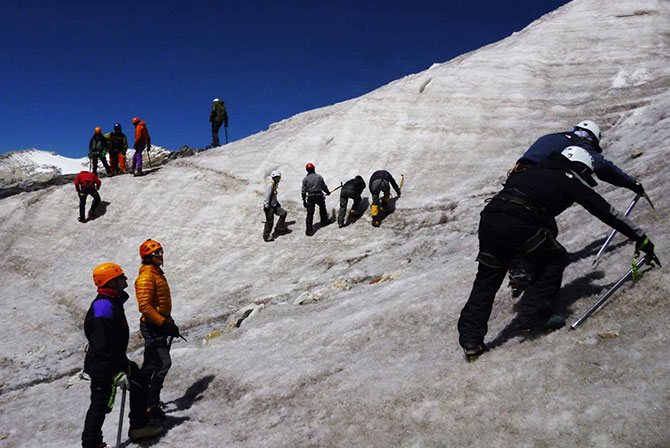
We always recommend you should have a good travel insurance for a trip to Bolivia as it can save so much stress and expense should you have a incident during your trip,
When it comes to mountaineering and trekking it is evenmore advisible and if you are coming to Bolivia with the main purpose of climbing and/or trekking then a specialist insurance is the best way to go.
Many people though just decide to try their hand at climbing when they get to Bolivia and might just try a one off summit of Huayna Potosi for example.
If this is the case you should probably check your travel insurance to see if you will be covered as many policies do not cover mountain sports or have a limit of to what altitude they cover.
In fact a number of cheaper policies we have seen dont even cover you for just being in La Paz!
It is hard to get additional insurance cover when in La Paz, at least at decent prices, so it is much better if you can sort something out before leaving home.
In the UK the British Mounteering Council offers very good insurance packages which require you to become a member.
Membership of the BMC though means you recieve good discounts (usually 15 to 20%) at many outdoor gear stores so if you are buying equipment for a trip the discount can pay for itself
In the US the American Alpine Club is worth checking out , again you are entitled to discounts with membership and they arrange insurance packages through partners
Important - you should be aware that there are very limited search and rescue services in Boliivia.
The one service that does exist is made up of volunteers and whilst many members are certifed guides, fireman etc they have very little in the way of funds, equipment is mostly their own.
There arent any helicopter rescue services of the kind you see constantly whizzing buy in Alpine resorts like Chamonix.
If there is an incident it can take many hours for rescuers to get out to the area. If a helicopter is required then it would likely be from the miltary if anything is avaialble and incur a significant cost (1000s of USD).
The main reason therefore for having insurance is in case of medical costs, which for quality care can be expensive.
Useful Tips
- During high altitude climbs it is common for water inside water bottles to freeze. Do NOT attempt to use camelback type hydration systems as the tubes freeze even even than the bottles.
You can help negate your water freezing by using hydration salts in your water which helps stop freezing and also aids hydration - which is helpful to combat symptoms of altitude. - Climbing uses lots of energy but altitude makes most people have a reduced appetite so make sure you take high energy snacks such as nuts, chocolate or cereal bars or even better is to bring some energy bar or gels from home for easy to carry boosts during your climb.
Last Updated 7th August 2018
-
Tuni Condoriri - Pico Austria 1-Day Trek
Stunning scenery with amazing snowcapped peaks, beautiful Andean lakes, good altitude training before climbing or simply an easy way to go on a fantastic short trek in the majestic Cordillera Mountain range. Highly recommended for everyone and perfect for those who are short on time but still want to experience the stunning views only Andes can offer.
$75.00 -
Takesi Classic 2 or 3-Day Inca Trek
This is our budget Takesi Trek option. The Takesi trek is a popular trek from La Paz with some of the best Inca paving in the Andes. Mostly downhill it passes through cloud forest to semi-tropical rainforest. It is available to trek in 2 or 3 days and an English-speaking guide can be available upon request.
$155.00 -
Chacaltaya to Huayna Potosi 1-Day Trek
This short but challenging trek follows a high altitude trail between two of Bolivia's most famous mountains - Huayna Potosi and Chacaltaya. All of this trek is above 4500 meters so it is essential to be well acclimatised to undertake this. This is a good option as altitude training if you are planning Huayna Potosi later on.
$90.00


